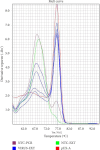Intestinal Form of Human Coronavirus 229E Plays No Role in Peritoneal Sclerosis Pathology in Dialysis Patients
- PMID: 40201573
- PMCID: PMC11978476
- DOI: 10.1155/av/2172144
Intestinal Form of Human Coronavirus 229E Plays No Role in Peritoneal Sclerosis Pathology in Dialysis Patients
Abstract
Infectious peritonitis is found to be a leading factor in the development of viral peritonitis (VP) and encapsulating peritoneal sclerosis (EPS) in patients undergoing peritoneal dialysis (PD) treatment. Bacterial and fungal infections are a major cause of peritonitis in PD patients. Viral infections have rarely been reported in association with peritonitis in PD patients; about 20% of cases are fungal and bacterial culture-negative (so-called sterile peritonitis). Several possible viral causes are reported to cause peritonitis, Coronaviruses are an important virus group that has been found to cause peritonitis in animals (cats), although in human beings these viruses have not been reported to associate with peritonitis. The purpose of this study was to investigate whether the intestinal form of Human 229E coronavirus plays a role in peritonitis and EPS for several peritoneal fluid samples collected from patients with confirmed EPS. Thirty-seven peritoneal fluid samples from 12 patients with histologically confirmed EPS from Manchester University Hospitals were extracted using QIAamp RNA Mini Kit to purify viral RNA. The purified RNA was reverse transcribed and tested using a pan-coronavirus PCR designed to pick up all known human and animal coronaviruses. None of the peritoneal fluid samples was positive, suggesting that active coronavirus infection is not associated with the development of VP in dialysis patients.
Keywords: coronavirus 229E; encapsulating peritoneal sclerosis (EPS); pan-human coronavirus PCR; peritoneal dialysis (PD); viral peritonitis.
Copyright © 2025 Sirwan Sleman. Advances in Virology published by John Wiley & Sons Ltd.
Conflict of interest statement
The author declares no conflicts of interest.
Figures


Similar articles
-
Persistent sterile peritoneal inflammation after catheter removal for refractory bacterial peritonitis predicts full-blown encapsulating peritoneal sclerosis.Perit Dial Int. 2013 Sep-Oct;33(5):507-14. doi: 10.3747/pdi.2012.00281. Epub 2013 Aug 1. Perit Dial Int. 2013. PMID: 23907832 Free PMC article.
-
Risk factors for encapsulating peritoneal sclerosis: Analysis of a 36-year experience in a University Hospital.Nephrology (Carlton). 2017 Nov;22(11):907-912. doi: 10.1111/nep.12911. Nephrology (Carlton). 2017. PMID: 27556577
-
Risk factors for encapsulating peritoneal sclerosis in long-term peritoneal dialysis: a retrospective observational study.Ther Apher Dial. 2014 Feb;18(1):68-73. doi: 10.1111/1744-9987.12048. Epub 2013 Apr 17. Ther Apher Dial. 2014. PMID: 24499086
-
Current Status of Peritoneal Dialysis in Japan.Contrib Nephrol. 2018;196:123-128. doi: 10.1159/000485711. Epub 2018 Jul 24. Contrib Nephrol. 2018. PMID: 30041216 Review.
-
Encapsulating peritoneal sclerosis: Your questions answered.Perit Dial Int. 2023 Mar;43(2):119-127. doi: 10.1177/08968608221125606. Epub 2022 Oct 2. Perit Dial Int. 2023. PMID: 36189954 Review.
References
-
- Corr C. A “New Normal”: Life on Dialysis-The First 90 Days . National Kidney Foundation, Inc; 2007.
-
- Hansson J. H. Clinical Decisions in Nephrology, Hypertension And Kidney Transplantation . Springer; 2013. Peritoneal Dialysis: Initiation and Complication.
-
- Goffin E. J., Krediet R. T. Nolph and Gokal’s Textbook of Peritoneal Dialysis . Springer; 2022. Encapsulating Peritoneal Sclerosis. - DOI
-
- Mactier R., Brown M. Progress in Peritoneal Dialysis . InTech; 2011. Encapsulating Peritoneal Sclerosis in Incident PD Patients in Scotland.
LinkOut - more resources
Full Text Sources
Miscellaneous

